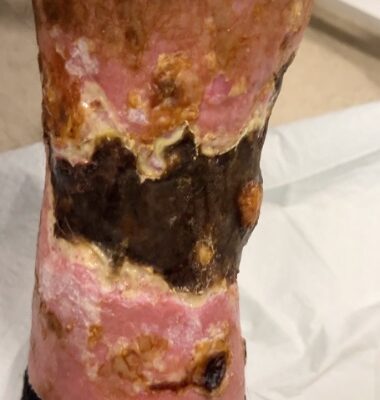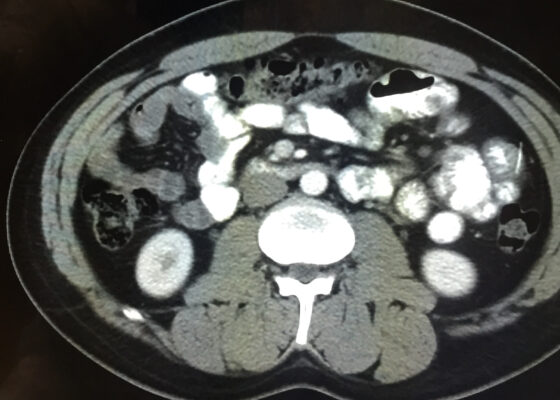Latest Articles
A Case Report of Calciphylaxis
DOI: https://doi.org/10.21980/J8KW8VOn arrival for this visit, the patient was nontoxic appearing with stable vital signs. The physical exam was notable for deep, ulcerated, bilateral anterior leg wounds with purulent drainage and large areas of eschar (see photographs).
Case Report: Iatrogenic Bowel Perforation Following Dental Procedure
DOI: https://doi.org/10.21980/J8CD38The patient’s abdominal CT demonstrated a metallic foreign body in the left side of the abdomen within the small bowel, without surrounding induration or abscess. Radiology questioned whether the metallic foreign object perforated the bowel. Seen in the cross-sectional CT image, there is a hyperdense linear structure transversing the small intestinal wall, given that a portion of the structure was located outside of the lumen of the bowel.
Diabetic Ketoacidosis and Necrotizing Soft Tissue Infection
DOI: https://doi.org/10.21980/J89M0KAt the end of this oral board session, examinees will: 1) Demonstrate the ability to obtain a complete medical history and physical exam. 2) Identify and appropriately treat DKA. 3) Identify, treat, and make appropriate consults for NSTI. 4) Demonstrate effective communication of the treatment plan with the patient.
My Broken Heart
DOI: https://doi.org/10.21980/J85W7RBy the end of this simulation session, learners will be able to: 1) assess the hemodynamics of an LVAD patient by using a Doppler to determine mean arterial pressure, 2) Manage an arrhythmia in an LVAD patient with a suction event by addressing preload, 3) Identify and treat the source of hypovolemia (a massive lower gastrointestinal hemorrhage), 4) Perform clear closed-loop communication with other team members.
Stabilization of Cardiogenic Shock for Critical Care Transport, a Simulation
DOI: https://doi.org/10.21980/J82354ABSTRACT: Audience: This simulation is designed for critical care transport providers but can be easily adapted for the inpatient setting. It is applicable to an interdisciplinary team including nurses, respiratory therapists, medical students, emergency medicine residents, and emergency medicine attendings. Introduction: Cardiogenic shock carries an incredibly high burden of morbidity and mortality. Acute myocardial infarction accounts for 81% of cardiogenic


